

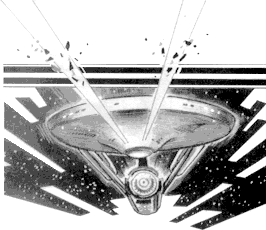
R & R Software, the people who brought us one of the earliest Spectrum Star Trek versions and one of the best creepies in Spectipede, are busily going where few ZX men have gone before — namely South Africa and New Zealand! In these far off places the Spectrum is still in its infancy but selling well Bob Brenchley of R&R tells me. He’s hoping the success of the Spectrum will keep Japanese and American imports at bay, but to help he is ensuring British software for the computer is readily available to back up hardware sales.
One angle is supporting software sales in CRASH magazine which Bob has chosen to export to South Africa. With the magazine, it is hoped, both dealers and computer owners will be able to see what’s happening here in Britain and what the games are all about.
Another Trekkster on the move is Derek Brewster of Neptune Computing. His Star Trek has proved very popular although its never been strongly advertised. Now an improved new version is available from Mikrogen, who are marketing it for Derek. In fact this version has gone through six stages — the one out previously was number four.
‘It’s vastly improved upon the older one,’ Derek told me, ‘in fact the program is quite unrecognisable. There are more graphics and it works in real time.’
Graphically, the screen has been tidied up with all the relevant status reports shown in clearly defined coloured boxes beside the view screen. The Short Range Scan is also more detailed with clear shapes for the Enterprise, Klingon ships and bases. But the biggest change is noticeable during the battles. Instead of having to sit helplessly while the enemy fire away at your position, you can now type in commands via interrupt and the computer processes them as soon as it can. This obviously speeds up the thinking process required and makes it even more a game two or three people can enjoy at the same time. At the time of writing, I am unsure when this version will be available, but look out for a full review in the next issue.
Meanwhile Derek has also been doing programs for Micromega — I’m told Haunted Hedges is selling very well — and I’ve just seen the new one, Starclash which will be out by now. Again we’ll be reviewing it more fully in the next issue, for now I’ll just say it’s a shoot ’em up which looks deceptively easy! And then there’s Invasion 2000 — this one so new I haven’t been able to see anything yet. Derek tells me it’s a working title and Micromega may well alter it to something else before it appears.
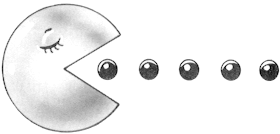
In Imagine’s Arcadia, the Atarian Battle Fleet look unstoppable. Turning their attention to the Spectrum and other computers, games giant Atari International are releasing some of their famous games like Pac Man, Miss Pac Man, Defender, Galaxians and Centipede over the next few months. The first out is Pac Man for the Spectrum. The idea is to make the games as close to the arcade originals as possible. Pac Man will be 16K and uses just over 9K of program. There isn’t an ounce of BASIC in it, not even a loader program — they get it to run by manipulating the machine stack. To squeeze it all in they are using some odd areas of memory address, the hi-score, for instance, is in MEMBOX. The result is a version with all the original tunes and animation between screens. Miss Pac Man, following soon after is even more detailed and requires 48K. Unlike Pac Man which uses moving characters Miss Pac Man is done with interrupt-based sprites and moving pixel graphics to give it a look very like you would see on a much bigger arcade machine. There are all the original animation stories between screens too.
The question remains as to how popular these games will be. Undoubtedly they will be of extremely high quality, but will their ‘official version’ status make them big sellers? After all, there are already numerous versions for the Spectrum on the market, and at much lower prices than the £14.99 Atari are charging. Paying a little extra for ‘artistic input’, as Eric Salaman UK Marketing Manager for Atari calls it, might be acceptable, but almost three times as much...?
Joe the Lion is the unlikely but likeable name of a new software company based in Hyde, Cheshire. In fact the new outfit has older connections, as it is a member of the PASE Group whose Pasesoft has been marketing Paseman since the early summer. Mr Holt from Joe the Lion told me that they hope to become market leaders in 1984 and are not sparing any expense in the production of their games and added, formidably, that they are nothing to do with Pasesoft, but that the two companies will be operating independently of each other, side by side.
The first three games are Challenger for the BBC, Loki for the 48K Oric and Bimbo for the 16K/48K Spectrum. I haven’t seen Bimbo yet and we’ll be reviewing it in the next issue no doubt, but the description says that: armed only with a carrot-detecting radar and a handful of apples to distract his pursuants, Bimbo Rabbit must seek out and eat all the carrots in a large maze of which only a small section is visible. The price is £5.45.
Software Projects Ltd of Liverpool (whose Push Off we review in this issue) is a new software house, but the members of the company are by no means new to games software. Alan and Soo Maton left leading software house Bug-Byte to form Software Projects together with Matthew Smith. Matthew is undoubtedly best known for writing one of 1983’s best games, Manic Miner. Although still too young to legally become a shareholder in the company, Matthew will be receiving his shares on his eighteenth birthday, this February.
Software Projects is already hard at work on some new games for the New Year. Matthew Smith is currently writing an eagerly awaited sequel to Manic Miner entitled Jet Set Willy. The game, says Alan Maton, continues where Manic Miner left off, only now Willy is a millionaire from his sub-Surbiton mining exploits. The action takes place at parties being thrown in Willy’s new mansion (thrown being the operative word no doubt!)
Another full time member of staff is sixteen-year old Chris Cannon, author of Bug-Byte’s adventure The Castle. Chris will be looking after the technical side of things.
Matthew Uffindel, one of our reviewers, will be pleased to know how good his judgement is. Having spent hours playing Perfection Software’s Odyssey 1, he spent the next few hours raving about it. Now he’s been backed up by the judges of the Cardiff Computech 83 Competition. Perfection’s young programmer, Timothy Williams, won first prize in the games section of the competition. Organised by the Polytechnic of Wales and the Western Mail newspaper, the competition was open to schools and colleges throughout Wales.
Timothy’s boss (and father) Brian Williams, told me they were delighted by the judges decision, and that he was sure all along that the 100% machine code Odyssey 1 would win. The first prize was presented by the Secretary of State for Wales, Nicholas Edwards — it was a BBC Model B Micro. I hope that does not mean we won’t be seeing any more games for the Spectrum from Perfection!

On to a more serious note: C.C.S. have announced the winner of the 1983 Cambridge Award, a programming competition for the Spectrum and ZX81, which they run in conjunction with Sinclair User.
The winner was Mark Lucas with BATTLE 1917, described as a highly original strategic war game written for the Spectrum 48K for 2 players. The game is based on the campaign of the First World War and requires players to exercise all the skills and tenacity of the Generals during that dreadful conflict. We shall be reviewing the game in the next issue.
Mark was presented with his prize of £1,000 and the Cambridge Award Trophy on Saturday 3rd December at the 9th ZX Microfair at Alexandra Palace.
Dr Tim Langdell of Softek tells me that they are in the midst of putting in a development system for programming games this year. It’s cost a lot of money, especially as it is being custom built for them, but Dr Langdell believes that games players will no longer put up with the kind of programs which have flooded the market throughout last year. He told me that they get many youngsters approaching them with very good ideas for games but with only a rudimentary knowledge of writing well in machine code.
Very soon we should be seeing Softek’s first ever adventure games. Dr Langdell’s speciality is artificial intelligence, and he is planning that Softek’s first excursion into adventures will make the Hobbit look out of date — at last. Keep your eyes peeled for more news adventure freaks!
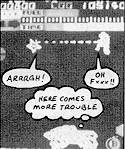
Have you heard Lunar Jetman talk yet? If you have then you must already own a Micro Speech unit from Currah Computers. Knowing how hard Jetman is to play, one might suppose that all he does is swear to himself with every new hole in the ground but in fact it’s the aliens who do all the muttering!
Seventeen games are already available (at the time of going to press) that will talk if you have a Micro Speech unit including Atic Atac, Lunar Jetman, The Birds and the Bees from Bug-Byte, Blastermind from Martech, Mined-Out from Quicksilva and parts 1-4 of the Digital Fantasia Mysterious Adventures. I am told that 32 software houses to date are now planning immediate releases of games which talk, so the Micro Speech unit looks like being good value at £29.95. On top of the games you can use Micro Speech to add sound to your own programs and all the volume is pumped out through your television set for added impact. Some existing sound on program systems tend to slow down the game because the computer has to process more information, but Micro Speech is interrupt operated which means it hardly interferes with the playing speed at all.
Look out for a detailed review of Micro Speech in a future issue soon, when we’ll be putting it through its verbal paces.
 Commander Locke, Chairman of the Ludlow Computer Club. |
Seven thousand eager visitors to the 9th ZX Micro Fair at Alexandra Palace last August received sticky black fingers from the CRASH Micro Games Action brochure! It was hot inside the pavilion and some of the printers ink came off the paper. For those who took part in the CRASH SUPER DRAW, and thousands did, you may be interested to know who the winners were. The draw took place, as promised, on September 20th. and was made by the Chairman of Ludlow Computer Club, Commander Locke.
The lucky winner, who received £100 worth of games software, was Daniel Rigal of London E2. The four runners up were D Bedford of Langley, Slough; G Devonport of Barkway, Herts; Paul Holloway of Hayes, Middx; and PJ Morse of Welwyn Garden City, Herts. The runners up each received £10 worth of games software.
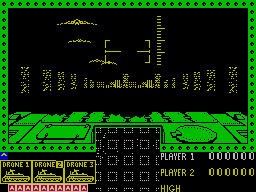
Imagine you’re a tank commander bathing to defend a city from attack by Seiddab aliens and you have some idea of what it’s like to play 3D Seiddab Attack, the latest arcade game from Hewson Consultants for the 16/48K Spectrum. The Seiddab (Baddies backwards!) were the aliens in 3D Space Wars, and now you must fight them again, controlling your tank in the city streets while alien airborne craft swoop and attack. If you can seek out the Seiddab ‘Task Force Leader’ before your tank armour is destroyed by enemy fire, the game moves to the next level in a countryside setting.
Increasing levels of difficulty make 3D Seiddab Attack challenging and the effective 3D graphics make many other games seem dull by comparison. Other features are 2-player scoring, hi-score, radar scanner and a warning display when tank missiles number less than 10.
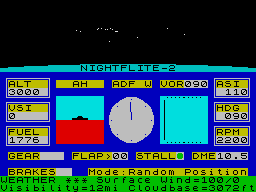
On show at the December ZX Microfair was Hewson’s Nightflite II, an enhanced version of the successful flight simulator Nightflite. Nightflite II is written entirely in machine code, so despite all the added features it runs on either a 16 or 48K Spectrum. Among the exciting new features are a shifting perspective which shows the correct view of runway lights and surrounding hamlets from whichever direction the airfield is approached. There is also a realistic engine sound which varies with engine speed making the simulation a close approximation to real flight experience.
All this is possible because the author of Nightflite II Mike Male, is a keen aircraft pilot and air traffic controller by profession. Consequently the game is based on real experience.
The program includes a flight debrief after every flight and which may be printed out complete with Mike Male’s signature, as a permanent record of the flight. Other features include: seven modes of operation, including two antipilot modes and a training mode; six levels of difficulty; variable flap controls; and realistic cockpit instruments.
3D Seiddab Attack is priced £5.95 and Nightflite II is £7.95, both games are available from all good software retailers or direct from Hewson Consultants.